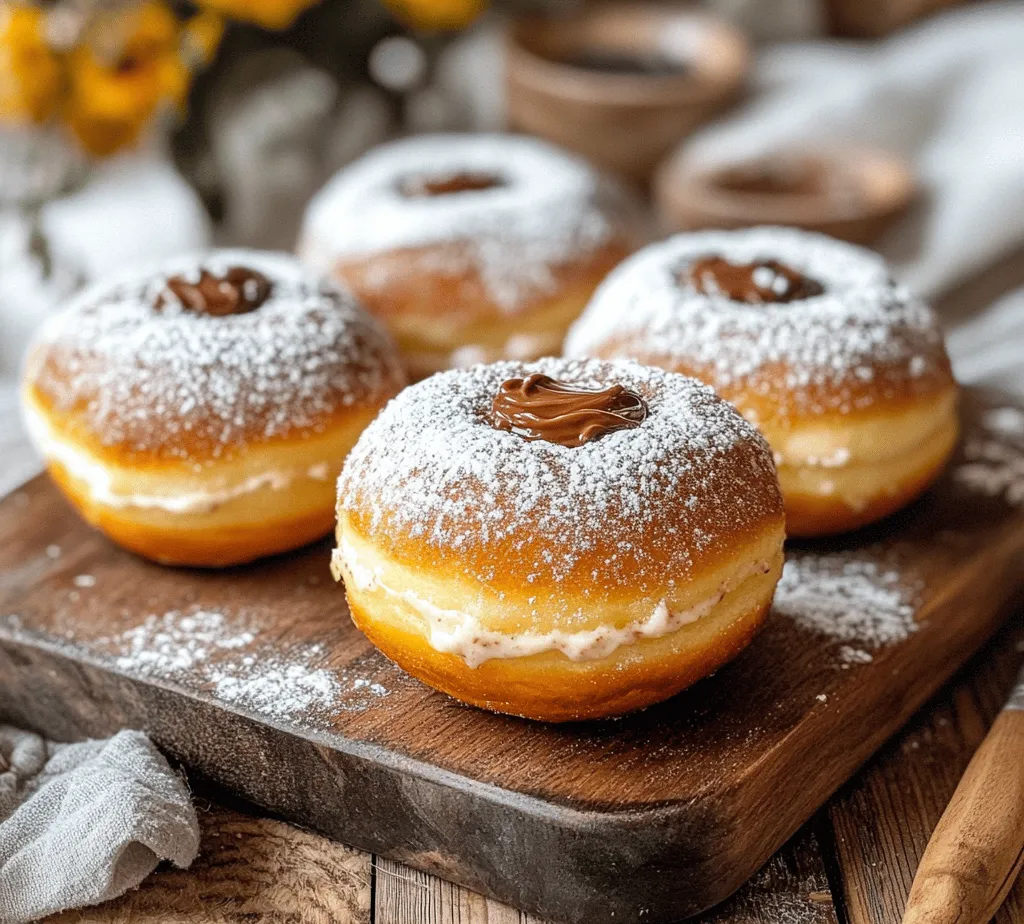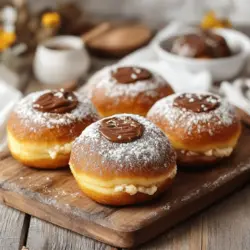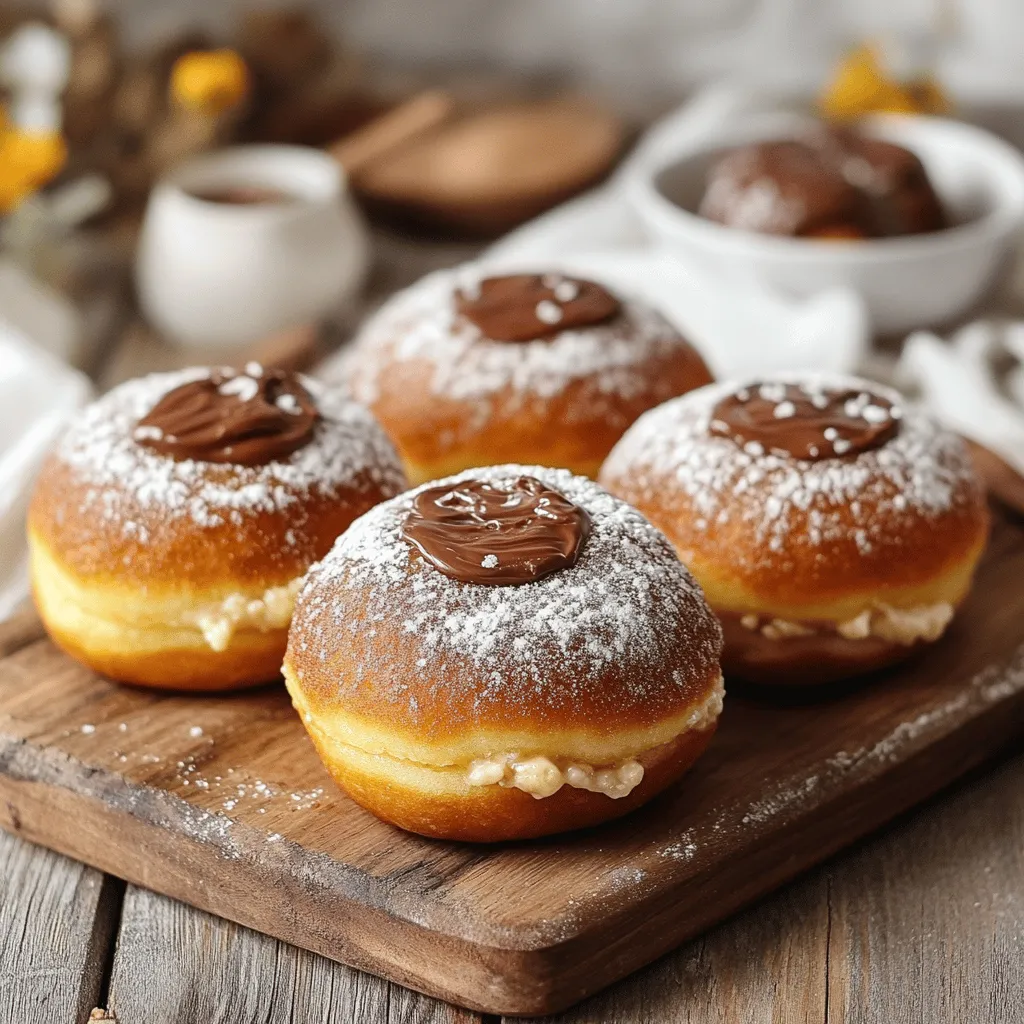Introduction
Donuts have long held a special place in the hearts—and stomachs—of dessert lovers around the globe. From classic glazed varieties to innovative flavors, these sweet treats have evolved into a versatile canvas for culinary creativity. The joy of biting into a freshly made donut, warm and pillowy, is a simple pleasure that many cherish. However, there’s something truly magical about the experience of making them at home. The aroma of frying dough, the anticipation of filling them with delicious surprises, and ultimately, the satisfaction of indulging in your creation make for an unforgettable experience.
One such delightful creation is the Nutella Delight Stuffed Donuts. This decadent twist on a classic favorite combines the soft, airy texture of homemade donuts with the rich, chocolatey goodness of Nutella, creating a treat that is sure to impress family and friends alike. Whether you’re hosting a brunch, celebrating a special occasion, or simply treating yourself, these stuffed donuts are a surefire way to elevate your dessert game.
In this recipe, we will emphasize the importance of using quality ingredients, as they play a crucial role in enhancing both flavor and texture. The difference between a good donut and a great one often lies in the ingredients you choose. So, gather your baking essentials, and let’s embark on this delicious adventure.
Understanding the Ingredients
To create the perfect Nutella Delight Stuffed Donuts, it’s essential to understand each ingredient’s role in the recipe. Here’s a closer look at what you’ll need:
All-Purpose Flour
All-purpose flour serves as the foundation of your donut dough. Its moderate protein content provides the necessary structure and texture, ensuring that the donuts are soft yet sturdy enough to hold their shape during frying. For the best results, it’s crucial to measure the flour accurately, as too much can lead to a dense product.
Granulated Sugar
Granulated sugar adds sweetness to the donuts, but its role extends beyond flavor. It acts as a browning agent during frying, giving the donuts that beautiful golden color we all love. Additionally, sugar contributes to the overall moisture content of the dough, helping to keep the finished product tender and moist.
Instant Yeast
Instant yeast is a vital ingredient in this recipe, responsible for the leavening process that creates the fluffy texture of the donuts. Unlike active dry yeast, instant yeast can be mixed directly with the dry ingredients without the need for proofing. This not only streamlines the preparation process but also ensures that your donuts rise effectively. Always check the expiration date on your yeast to ensure optimal performance.
Salt
While it may seem counterintuitive to add salt to a sweet recipe, it’s an essential component. Salt enhances flavor and balances sweetness, making the overall taste of the donuts more complex and appealing. Just a pinch can elevate your baked goods from good to great.
Whole Milk
Whole milk contributes moisture and fat to the dough, resulting in a rich and tender texture. The fat content in whole milk helps to create a soft crumb, while also enhancing the flavor of the donuts. If you don’t have whole milk on hand, you can substitute it with 2% milk, but the richness may be slightly compromised.
Eggs
Eggs are a crucial binding agent in donut recipes. They provide structure, moisture, and richness to the dough, contributing to its elasticity and overall texture. When using eggs, it’s best to bring them to room temperature before mixing, as this helps them integrate more smoothly into the dough.
Unsalted Butter
Unsalted butter adds an extra layer of flavor and richness to the donuts. Using unsalted butter allows you to have better control over the salt content in your recipe. When melted and incorporated into the dough, it helps create a tender crumb and a delightful buttery flavor that complements the sweetness of the donuts.
Vanilla Extract
Vanilla extract is a flavor enhancer that brings warmth and depth to the donuts. A touch of vanilla elevates the overall taste profile, making the donuts even more delicious. Always opt for pure vanilla extract when possible, as artificial versions can lack the complexity of flavor found in natural extracts.
Nutella or Hazelnut Spread
The star ingredient of this recipe is undoubtedly Nutella or any quality hazelnut spread. This luscious chocolate-hazelnut delight is what sets these stuffed donuts apart, providing a creamy, decadent filling that contrasts beautifully with the light, fluffy exterior. For those who prefer a different flavor, alternative fillings like fruit preserves or cream cheese can be used, but Nutella remains the ultimate choice for indulgence.
Oil for Frying
Choosing the right oil for frying is crucial to achieving the perfect donut. A neutral oil with a high smoke point, such as vegetable oil or canola oil, is ideal. These oils will not impart any unwanted flavors to your donuts and will allow for even frying, resulting in a crispy exterior. Make sure to heat the oil properly to avoid greasy donuts; the right temperature will ensure that the donuts cook evenly.
Powdered Sugar
Powdered sugar is the final touch that adds both sweetness and an appealing presentation to your donuts. After frying, a light dusting of powdered sugar gives the donuts a beautiful finish while enhancing their sweetness. For an extra touch, you can mix the powdered sugar with cocoa powder for a chocolatey twist.
Step-by-Step Guide to Making Nutella Delight Stuffed Donuts
Making the Dough
Now that we’ve covered the essential ingredients, it’s time to start making the dough for your Nutella Delight Stuffed Donuts. Follow these steps for a successful outcome:
1. Prepare Your Workspace: Clean and clear your kitchen counter, and gather all ingredients and equipment. You will need a mixing bowl, measuring cups and spoons, a whisk, a rolling pin, a doughnut cutter or two round cookie cutters, and a deep frying pan or deep fryer for frying.
2. Mixing Dry Ingredients: In a large mixing bowl, combine the all-purpose flour, granulated sugar, instant yeast, and salt. Whisk together until well blended. Mixing these dry ingredients first ensures that the yeast is evenly distributed throughout the flour, which is essential for proper rising.
3. Mixing Wet Ingredients: In a separate bowl, whisk together the whole milk, eggs, melted unsalted butter, and vanilla extract. Make sure the melted butter has cooled slightly—hot butter can cook the eggs if added directly.
4. Combining Ingredients: Gradually pour the wet mixture into the dry ingredients, stirring with a wooden spoon or spatula until a shaggy dough forms. Mixing the two separately allows for better incorporation of the yeast and helps prevent clumping.
5. Kneading the Dough: Once the dough has come together, turn it out onto a lightly floured surface. Begin kneading the dough by folding it over itself and pushing it down with the palms of your hands. Continue this process for about 8-10 minutes until the dough is smooth and elastic. If the dough feels too sticky, sprinkle a little more flour as needed, but be cautious not to add too much, as this can lead to dense donuts.
6. First Rise: Form the kneaded dough into a ball and place it in a lightly greased bowl, turning it to coat all sides with oil. Cover the bowl with a clean kitchen towel or plastic wrap, and place it in a warm location to rise. Allow the dough to double in size, which should take about 1-2 hours, depending on the room temperature.
This initial phase of making the dough is crucial for developing flavor and texture. Once your dough has risen, you will be well on your way to creating those delightful Nutella-stuffed donuts that will impress anyone lucky enough to get a taste. Stay tuned for the next steps as we progress in crafting these irresistible treats!

The Kneading Process and Its Significance
Kneading is a crucial step in donut-making that contributes to the texture and structure of the dough. When you knead, you are developing the gluten in the flour, which gives the donuts their characteristic chewy texture. Proper kneading also helps to incorporate air into the dough, making it light and fluffy after frying. Aim to knead your dough for about 8-10 minutes, either by hand or using a stand mixer with a dough hook. The dough should become smooth and elastic, pulling away from the sides of the bowl.
How to Know When the Dough is Ready
To determine if your donut dough is ready, perform the “windowpane test.” Take a small piece of dough and stretch it gently between your fingers. If it stretches without tearing and forms a thin, translucent membrane, your dough is ready. Another indicator is the dough’s texture; it should feel soft and slightly tacky but not sticky. If the dough is too sticky, incorporate a bit more flour, but be careful not to add too much, as this can lead to dense donuts.
Shaping the Donuts
After the dough has risen and doubled in size, it’s time to shape your donuts. Gently punch down the dough to release any trapped air, then turn it out onto a floured surface. Roll the dough out to about ½ inch thick. It’s essential to use enough flour to prevent sticking, but not so much that it alters the dough’s texture.
Techniques for Rolling and Cutting Out Donut Shapes
For cutting out the donuts, you can use a round cookie cutter or a glass, typically around 3 inches in diameter. To create the donut holes, use a smaller cutter, about 1 inch in diameter. Press down firmly but avoid twisting the cutter, as this can seal the edges of the dough and prevent them from rising properly. After cutting out the donuts, place them on parchment-lined baking sheets, ensuring they have enough space to rise.
Importance of Allowing the Donuts to Rise Again
Once shaped, the donuts need to rise again for about 30-45 minutes. This second rise, known as “proofing,” is essential for achieving a light and airy texture. Cover the donuts with a clean kitchen towel to prevent them from drying out. As they proof, the yeast will continue to work, creating bubbles that will expand during frying, resulting in deliciously fluffy donuts.
Preparing the Nutella Filling
While your donuts are rising, it’s time to prepare the Nutella filling. Simply transfer your Nutella into a piping bag fitted with a round tip. If you don’t have a piping bag, you can use a ziplock bag with a corner snipped off. This will make filling the donuts easier and more precise.
Best Practices for Filling Donuts: Piping Bag vs. Ziplock Bag
Using a piping bag is often the preferred method for filling donuts, as it provides better control and allows for a more even distribution of the filling. If using a ziplock bag, ensure the filling is at the bottom corner of the bag and squeeze gently to avoid spills. Make sure to fill the donuts generously but avoid overfilling, as this can cause the filling to leak out during frying.
Frying the Donuts
Frying your stuffed donuts is where the magic happens. Heat oil in a deep frying pan or a deep fryer to around 350°F (175°C). It’s crucial to maintain this temperature to ensure the donuts cook evenly without absorbing too much oil. Use a thermometer to monitor the oil temperature closely.
Overview of Frying Techniques and Temperature Control
When frying, add a few donuts at a time, making sure not to overcrowd the pan, which can cause the oil temperature to drop. Fry each donut for about 1-2 minutes on each side until they are golden brown. Use a slotted spoon or spider to gently turn the donuts in the oil. Once fried, transfer them to a wire rack lined with paper towels to drain excess oil.
Tips for Frying in Batches Safely
Frying in batches is essential for safety and ensuring even cooking. Always keep an eye on the temperature of the oil, and allow it to return to 350°F before adding the next batch. Have a plate lined with paper towels ready to absorb excess oil. If you notice smoke or the oil getting too hot, remove it from the heat to prevent burning.
Filling the Donuts
Once your donuts have cooled slightly, it’s time to fill them with Nutella. Insert the piping tip into the side of a donut and squeeze gently until you feel resistance. This indicates that the donut is adequately filled. Repeat this process for each donut, taking care not to puncture through the other side.
Method for Injecting Nutella Without Damaging the Donut Structure
To avoid damaging the structure of the donut, ensure that you’re inserting the piping tip only about halfway into the donut. This method allows you to fill the donut without compromising its integrity. Be gentle during the filling process, as excessive pressure can cause the donut to burst.
Dusting and Serving
Presentation is key when it comes to serving your Nutella Delight Stuffed Donuts. After filling, you can dust them with powdered sugar or dip them in granulated sugar for added sweetness. These finishing touches not only enhance the flavor but also make your donuts visually appealing.
Importance of Presentation
A well-presented dish can elevate the dining experience. Consider serving your donuts on a beautiful platter, possibly with a small bowl of extra Nutella for dipping. Garnishing with fresh berries or a drizzle of chocolate sauce can also add a touch of elegance and flavor.
Suggestions for Serving These Donuts Warm
For the best experience, serve your donuts warm. The warmth enhances the gooeyness of the Nutella filling, making them even more indulgent. If you have leftovers, you can reheat them in a microwave for a few seconds, but be careful not to overdo it, as this can make the donuts tough.
Tips for Perfecting Your Nutella Stuffed Donuts
Common Mistakes to Avoid During the Donut-Making Process
1. Over-kneading the dough: This can make donuts tough. Knead just until the dough is smooth and elastic.
2. Not allowing enough time for rising: Be patient during both rises; they are crucial for light, fluffy donuts.
3. Frying at the wrong temperature: Too hot can burn the outside before the inside cooks; too cold will make greasy donuts.
4. Overfilling the donuts: Keep it generous but controlled to prevent leaking.
Variations and Adaptations for Different Flavor Profiles
Feel free to experiment with different fillings. Try using flavored Nutella, chocolate ganache, or even fruit preserves. For a twist, consider adding spices like cinnamon or nutmeg to the dough for a warm flavor profile. You can also coat the donuts in a glaze made from powdered sugar and milk for a different texture and sweetness.
Nutritional Considerations
When indulging in Nutella Delight Stuffed Donuts, it’s useful to be aware of their nutritional content. Each donut typically contains around 250-300 calories, depending on the size and filling. While they are a delightful treat, it’s important to enjoy them in moderation.
Discussion on Indulgence vs. Moderation in Dessert Consumption
Desserts can be an expression of love and celebration, but balancing indulgence with moderation is key to a healthy lifestyle. These donuts serve as a reminder that it’s okay to indulge occasionally, especially when made from scratch. Enjoying them with family and friends can enhance the experience, making them a special treat rather than an everyday snack.
Conclusion
Making Nutella Delight Stuffed Donuts at home is a rewarding experience that combines the joy of baking with the satisfaction of crafting a delicious treat. Whether you are impressing friends at a gathering or enjoying them on a cozy morning, these donuts are sure to please. So roll up your sleeves, gather your ingredients, and dive into this delightful recipe. You’ll be amazed at how easy and enjoyable it is to create these scrumptious donuts, and you might just find that sharing them with loved ones makes your culinary adventure even sweeter.


